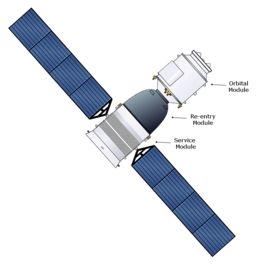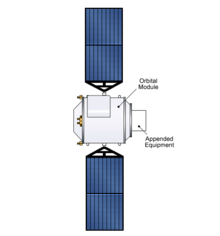Shenzhou (spacecraft)
 Diagram of the post-Shenzhou 7 spacecraft | |
| Country of origin | China |
|---|---|
| Operator | CNSA |
| Applications | Manned spaceflight |
| Specifications | |
| Design life | 20 days |
| Launch mass | 7,840 kilograms (17,280 lb) |
| Dimensions | 9.25 by 2.8 metres (30.3 ft × 9.2 ft) |
| Volume | 14.00 cubic metres (494 cu ft) |
| Regime | Low Earth |
| Production | |
| Status | In service |
| Built | 11 |
| Launched | 11 |
| Operational | 0 |
| Retired | 11 |
| Lost | 0 |
| First launch | Shenzhou 1, 1999 |
| Last launch | Shenzhou 11, 2016 |
| Related spacecraft | |
| Derived from | Soyuz |
Shenzhou (/ˈʃɛnˈdʒoʊ/[1] or /ʃɛnˈzuː/; Chinese: 神舟; pinyin: Shénzhōu) is a spacecraft developed and operated by China using Soyuz technology to support its manned spaceflight program. The name is variously translated as divine vessel,[2], divine craft,[3] or divine ship.[4] Its design resembles the Russian Soyuz spacecraft, but it is larger in size. The first launch was on November 19, 1999 and the first manned launch was on October 15, 2003. In March 2005, an asteroid was named 8256 Shenzhou in honour of the spacecraft.
History
China's first efforts at human spaceflight started in 1968 with a projected launch date of 1973.[5] Although China launched an unmanned satellite in 1970 and has maintained an active unmanned program since, this attempt was canceled due to lack of funds and political interest.
The first unmanned flight of the spacecraft was launched on November 19, 1999, after which Project 921/1 was renamed Shenzhou, a name reportedly chosen by Jiang Zemin. A series of three additional unmanned flights ensued. It is expected that later craft will be designed to carry a crew of four instead of Soyuz's three, although physical limitations on astronaut size, as experienced with earlier incarnations of Soyuz, will likely apply.
Missions launched
- Shenzhou 1 (神舟一号) – November 19, 1999 – unmanned test flight
- Shenzhou 2 (神舟二号) – January 9, 2001 – carried animals
- Shenzhou 3 (神舟三号) – March 25, 2002 – carried a test dummy[6]
- Shenzhou 4 (神舟四号) – December 29, 2002 – carried a test dummy and several science experiments
- Shenzhou 5 (神舟五号) – October 15, 2003 – 14 Earth orbits carrying Yang Liwei
- Shenzhou 6 (神舟六号) – October 12, 2005 – five-day mission with Fei Junlong and Nie Haisheng
- Shenzhou 7 (神舟七号) – September 25, 2008 – three-man crew with Zhai Zhigang, Liu Boming, and Jing Haipeng; spacewalk performed by two crew members
- Shenzhou 8 (神舟八号) – October 31, 2011 – unmanned mission carrying 2 test dummies, which rendezvoused and docked with Tiangong-1.[7]
- Shenzhou 9 (神舟九号) – June 16, 2012 – three-person crew (one female) with Jing Haipeng, Liu Wang and Liu Yang, docked with Tiangong-1. The spacecraft returned to earth on 29 June 2012 with three crew members appearing in good health.[8][9][10]
- Shenzhou 10 (神舟十号) – June 11, 2013 –The three-person crew (one female) with Nie Haisheng, Zhang Xiaoguang and Wang Yaping started and docked with Tiangong-1 two days later.
- Shenzhou 11 (神舟十一号) – October 17, 2016 – manned mission carrying crew to Tiangong-2.
Planned missions
- Shenzhou 12 (神舟十二号) – 2018[11]
Design
The Shenzhou spacecraft resembles the Soyuz, although it is longer, with a larger habitable volume. It features a powered service module like the Soyuz, and prior to Shenzhou 8 its orbital module was capable of autonomous flight. The general designer of Shenzhou-1 through Shenzhou-5 was Qi Faren (戚发轫, Apr 26, 1933 -), and from Shenzhou-6 on, the general design was turned over to Zhang Bainan (张柏楠, Jun 23, 1962 -).
Russia sold Soyuz technology to China in 1994. The design of Project 921-1 spacecraft was modified and eventually became the Shenzhou. [12]
Like Soyuz, Shenzhou consists of three modules: a forward orbital module (轨道舱), a reentry module (返回舱) in the middle, and an aft service module (推进舱). This division is based on the principle of minimizing the amount of material to be returned to Earth. Anything placed in the orbital or service modules does not require heat shielding, and this increases the space available in the spacecraft without increasing weight as much as it would if those modules were also able to withstand reentry. Thus both Soyuz and Shenzhou have more living area with less weight than the Apollo CSM.
- Complete spacecraft data
- Total mass: 7,840 kg
- Length: 9.25 m
- Diameter: 2.80 m
- Span: 17.00 m
Orbital module

The orbital module (轨道舱) contains space for experiments, crew-serviced or operated equipment, and in-orbit habitation. Without docking systems, Shenzhou 1–6 carried different kinds of payload on the top of their orbital modules for scientific experiments.
Up until Shenzhou 8, the orbital module of the Shenzhou was equipped with its own propulsion, solar power, and control systems, allowing autonomous flight. It was possible for Shenzhou to leave an orbital module in orbit for redocking with a later spacecraft, something which the Soyuz cannot do since the only hatch between orbital and reentry modules is a part of reentry module, and orbital module is depressurized after separation. In the future it is possible that the orbital module(s) could also be left behind on the planned Chinese project 921/2 space station as additional station modules.
In the unmanned test flights launched to date, the orbital module of each Shenzhou was left functioning on orbit for several days after the reentry modules return, and the Shenzhou 5 orbital module continued to operate for six months after launch.
- Orbital module data
- Design life: 200 days.
- Length: 2.80 m (9.10 ft).
- Basic diameter: 2.25 m (7.38 ft).
- Maximum diameter: 2.25 m (7.38 ft).
- Span: 10.40 m (34.10 ft).
- Habitable volume: 8.00 m³.
- Mass: 1,500 kg (3,300 lb).
- RCS Coarse No x Thrust: 16 x 5 N.
- RCS Propellants: Hydrazine.
- Electrical system: Solar panels, 12.24 m².
- Electric system: 0.50 average kW.
- Electric system: 1.20 kW.
Reentry module
The reentry module (返回舱) is located in the middle section of the spacecraft and contains seating for the crew. It is the only portion of Shenzhou which returns to Earth's surface. Its shape is a compromise between maximizing living space while allowing for some aerodynamic control upon reentry.
- Reentry module data
- Crew size: 3.
- Design life: 20 days.
- Length: 2.50 m (8.20 ft).
- Basic diameter: 2.52 m (8.26 ft).
- Maximum diameter: 2.52 m (8.26 ft).
- Habitable volume: 6.00 m³.
- Mass: 3,240 kg (7,140 lb).
- Heat shield mass: 450 kg (990 lb)
- Lift-to-drag-ratio (hypersonic): 0.30.
- RCS Coarse No x Thrust: 8 x 150 N.
- RCS Propellants: Hydrazine
Service module
The aft service module (推进舱) contains life support and other equipment required for the functioning of Shenzhou. Two pairs of solar panels, one pair on the service module, the other pair on the orbital module, have a total area of over 40 m² (430 ft²), indicating average electrical power over 1.5 kW (Soyuz have 1.0 kW).
- Service module data
- Design life: 20 days.
- Length: 2.94 m (9.65 ft).
- Basic diameter: 2.50 m (8.20 ft).
- Maximum diameter: 2.80 m (9.10 ft).
- Span: 17.00 m (55.00 ft).
- Mass: 3,000 kg (6,600 lb).
- RCS Coarse No x Thrust: 8 x 150 N.
- RCS Fine No x Thrust: 16 x 5 N.
- RCS Propellants: N2O4/MMH, unified system with main engine.
- Main engine: 4 x 2500 N.
- Main engine thrust: 10.000 kN (2,248 lbf).
- Main engine propellants: N2O4/MMH.
- Main engine propellants: 1,000 kg (2,200 lb).
- Main engine Isp: 290 sec.
- Electrical system: Solar panels, 24.48 + 12.24 m², 36.72 m² total.
- Electric system: 1.00 average kW.
- Electric system: 2.40 kW.
In media
- The Shenzhou was prominently featured in the film Gravity and was used by the main character, STS-157 Mission Specialist Dr. Ryan Stone, to safely return home after the destruction of her spacecraft[13][14].
- In Star Trek Discovery, the starship USS Shenzhou is named after this spacecraft.
See also
References
- ↑ "Shenzhou pronunciation". Dictionary.com. Retrieved 25 April 2015.
- ↑ "Expedition 7 Crew Members Welcome China to Space". NASA. 17 October 2003. Retrieved 17 August 2018.
- ↑ Scuka, Daniel (26 March 2018). "Tiangong-1 frequently asked questions". ESA. Retrieved 17 August 2018.
- ↑ "China's Shenzhou spacecraft – the "divine ship"". New Scientist. 12 October 2005. Retrieved 17 August 2018.
- ↑ Mark Wade (2009). "Shuguang 1". Encyclopedia Astronautica. Archived from the original on July 14, 2007. Retrieved March 4, 2009.
- ↑ "《北京晚报》:探秘"神舟"三号中的"假人"". Retrieved 4 April 2002.
- ↑
Amos, Jonathan (2011-10-31). "Chinese Shenzhou craft launches on key space mission". BBC. Retrieved 2011-11-01.
'China has taken the next step in its quest to become a major space power with the launch of the unmanned Shenzhou 8 vehicle... The Long March carrier rocket lifted away from the Jiuquan spaceport in the Gobi Desert at 05:58, Tuesday (21:58 GMT Monday). TV cameras relayed the ascent to orbit.' with the two piloted missions to be launched in 2012
- ↑ "Chinese astronauts return to Earth". thehindu.com. The Hindu. Associated Press. 29 June 2012. Retrieved April 23, 2017.
- ↑ David, Leonard (2011-03-07). "China Details Ambitious Space Station Goals". SPACE.com. Retrieved 2011-03-11.
- ↑ Stephen Clark. "China Sets Summer Launch For Next Human Spaceflight". SpaceflightNow.com. Retrieved 2012-02-18.
- ↑ "神舟十二号飞船(SZ-12):对接2018年发射升空的空间站核心舱。 - China Spaceflight". www.chinaspaceflight.com. Retrieved 2016-10-18.
- ↑ Futron Corp. (2003). "China and the Second Space Age" (PDF). Futron Corporation. Archived from the original (PDF) on April 19, 2012. Retrieved October 6, 2011.
- ↑ Kramer, Miriam (October 6, 2013). "The Spaceships of 'Gravity': A Spacecraft Movie Guide for Astronauts". yahoo.com. Yahoo. Retrieved April 23, 2017.
- ↑ Lyons, Lauren (October 19, 2003). "'Gravity,' China and the end of American Exceptionalism in outer space". spaceflightinsider.com. Spaceflight Insider. Retrieved April 23, 2017.
Further reading
| Wikimedia Commons has media related to Shenzhou. |
- "Shenzhou". Archived from the original on 13 October 2005. Retrieved 21 July 2005.
- "China's first astronaut revealed". BBC. March 7, 2003.
- "Brief history of Russian aid to Chinese space program". Archived from the original on 8 April 2007. Retrieved 7 June 2007.
- "Details on purchase of Soyuz descent capsule by China, Space.com". Archived from the original on 2 June 2008. Retrieved 7 June 2007.
External links
- Flickr: Photos tagged with shenzhou, photos likely relating to Shenzhou spacecraft
- Subsystems and Project management of Shenzhou 7